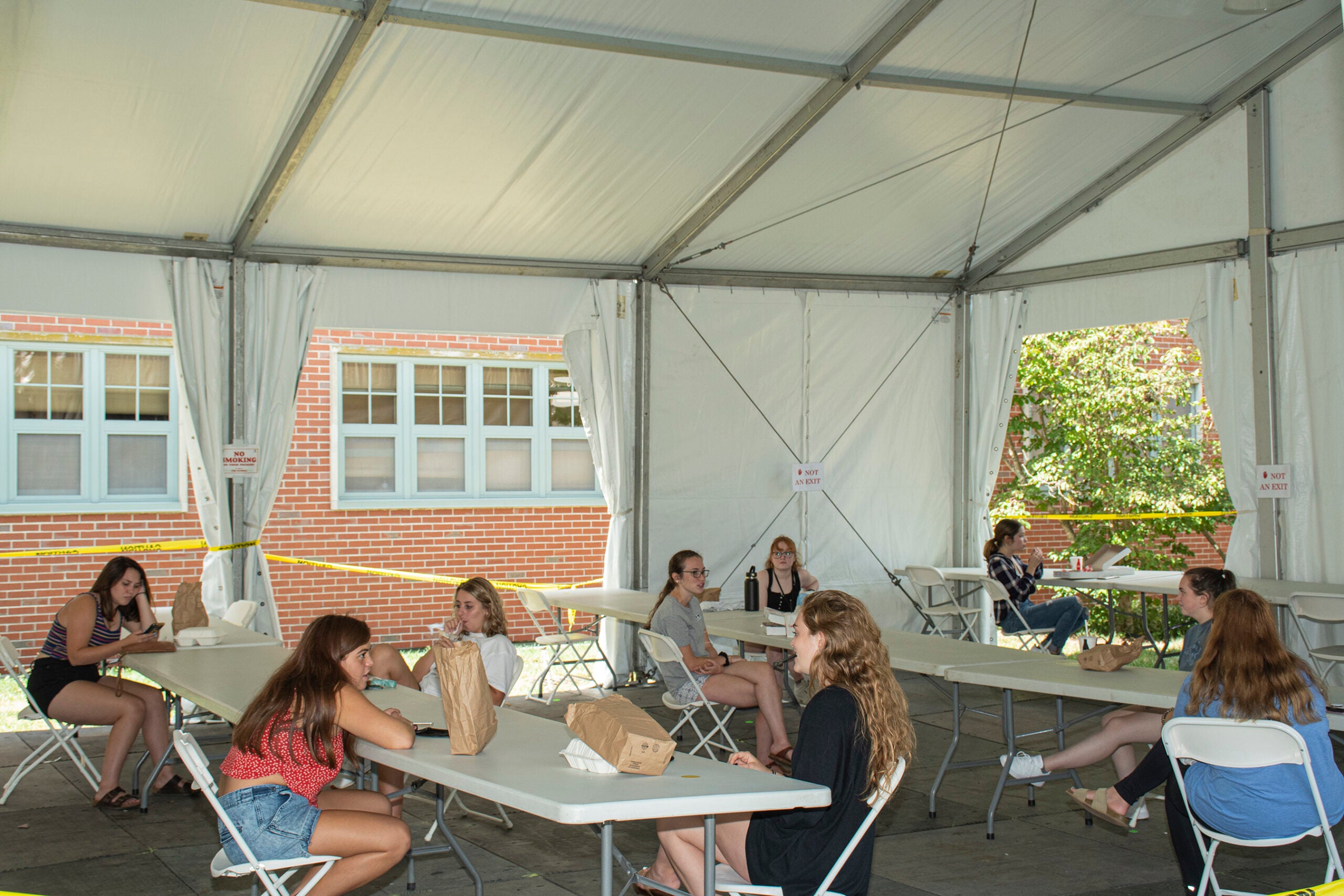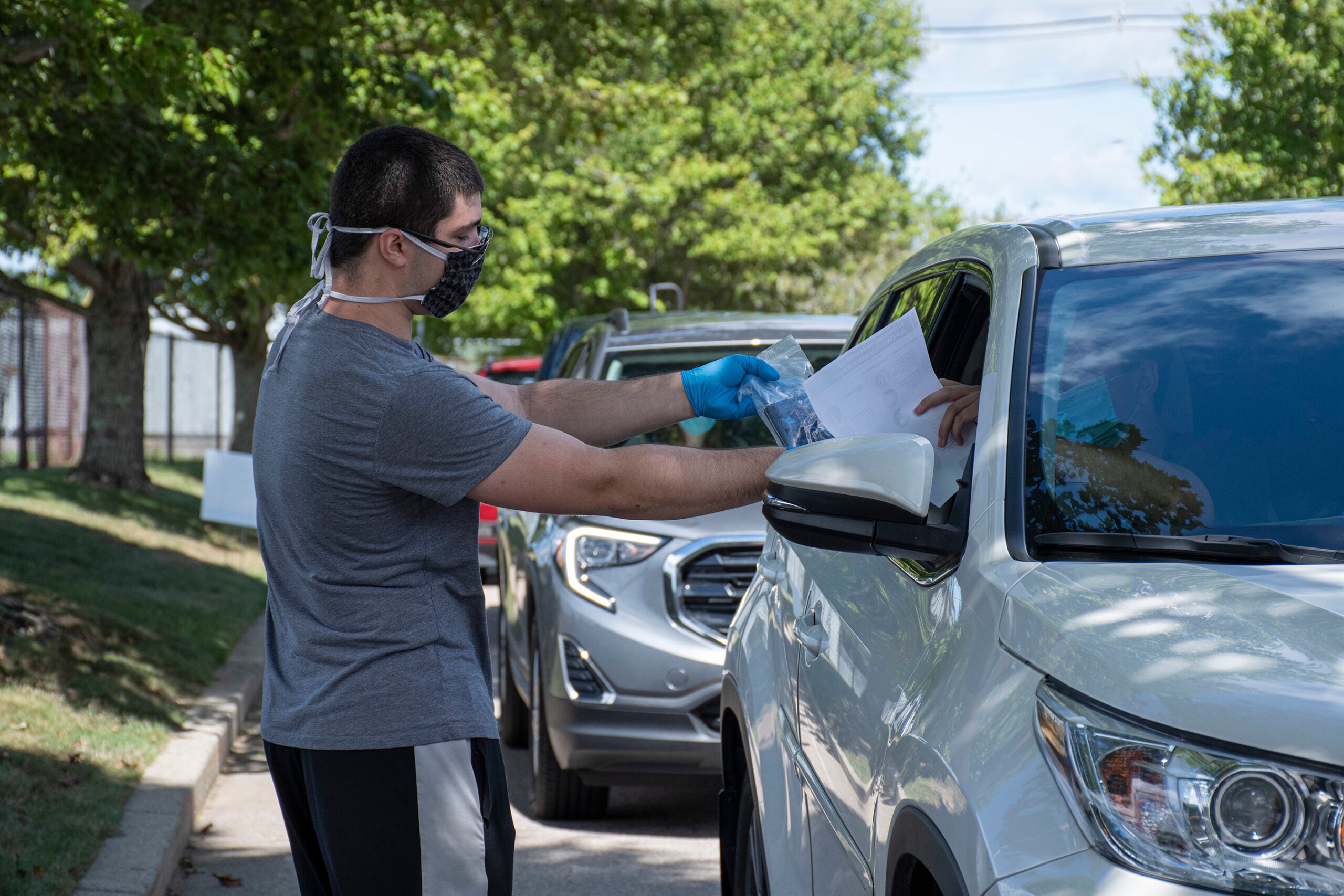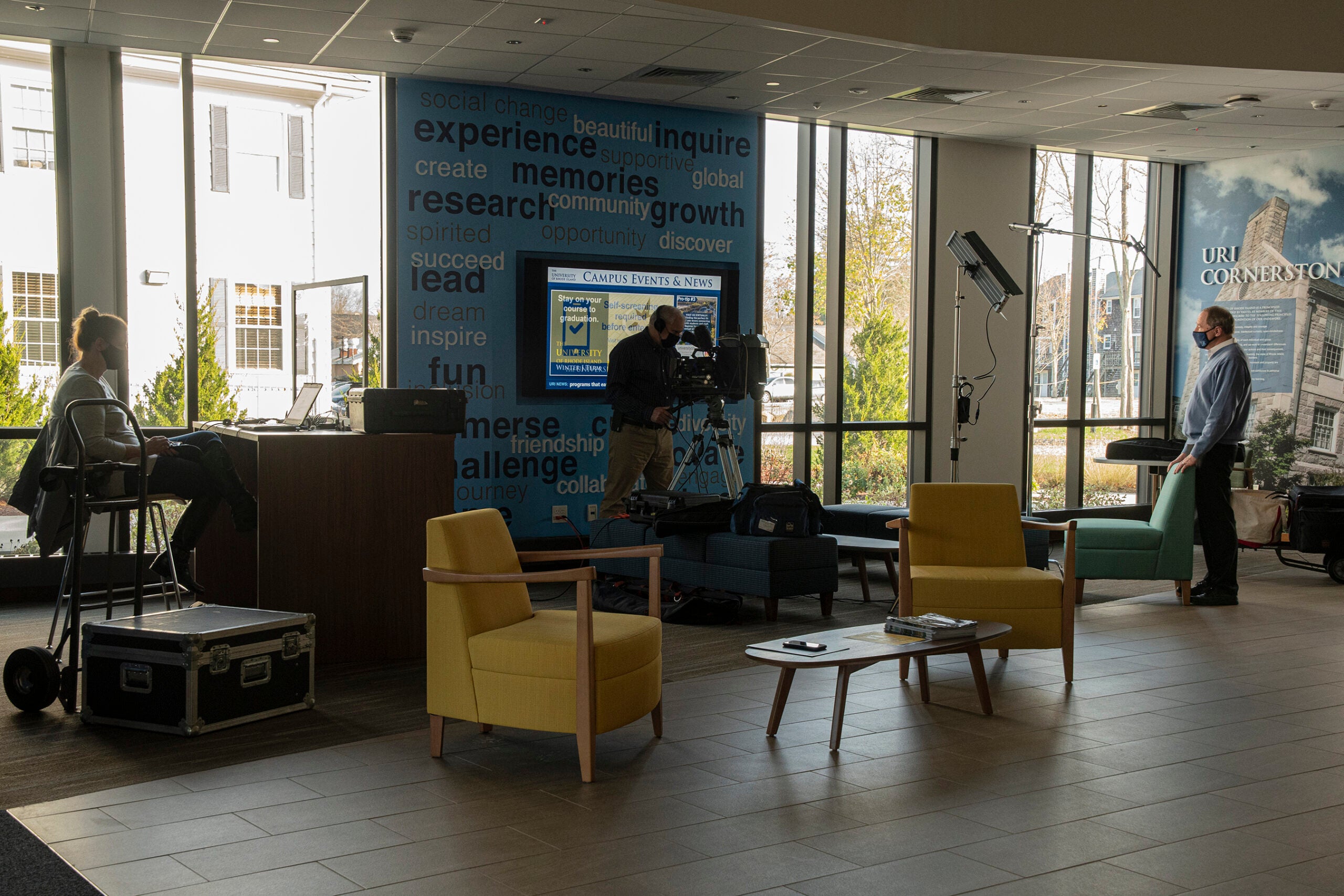KINGSTON, R.I. – Feb. 3, 2021 — They didn’t know it at the time, but members of a University team working to get seven students safely home from China in late January 2020 were building a collaborative model that continues to serve the University well during the COVID-19 pandemic.
Starting Jan. 29, 2020 and for several days after, the team gathered in the University’s Emergency Operations Center to get those first students back to the United States, and later the remaining study-abroad students safely home.
During those hectic early days, Ellen Reynolds ’91, assistant vice president for Health and Wellness and director of Health Services, called students a world away and reassured parents, while Cynthia Stanton ’91, M.P.A. ’17, director of Risk Management, turned into a travel agent, working with students and families to book flights home. Dean Libutti ’95, vice provost for Enrollment Management, was on the line constantly answering questions about how study abroad students could continue their academic progress when they returned.

Sam Adams Ph.D.’23, director of Emergency Management, and Cassie Whitworth, campus preparedness planner in Emergency Management, coordinated the operation to make sure tasks were completed. Bob Viens, associate director of Information Technology Services, was there providing tech support. And Gifty Ako-Adounvo, vice provost for global initiatives, and her team tracked down students’ locations, and provided phone numbers and email addresses to the team.
As the pandemic worsened and difficult decisions arose, that model was key to converting 3,000 in-person classes during the spring semester to online classes in about nine days — and putting 100 percent of summer session classes online while hitting enrollment targets for the fall semester. The University’s 2020 summer enrollment set a record, allowing students to maintain their progress toward graduation.
The Faculty Senate, working with the Provost Donald H. DeHayes and the Senior Leadership Team, developed a compassionate, thoughtful grading policy for the spring semester that emphasized student well-being and academic progress.
For the 2020 fall semester, that teamwork would enable the University to return to in-person classes, on-campus living and dining, and the delivery of academic programs using the latest teaching and learning technology. The University is not aware of a single positive COVID-19 test linked to an academic setting through its contact tracing.
On behalf of the URI Board of Trustees, Chair Margo L. Cook ’86, thanked the University community of students, faculty, and staff for their outstanding efforts during the pandemic.

“We recognize the challenges presented over the last year, and deeply appreciate your ability to learn, teach and work in a different environment, remaining flexible, resourceful and resilient,” Cook said. “And you’ve done it all with the Rhody spirit that we all know. The University has made incredible strides, including innovating new ways of thinking that will propel the University beyond this time. As stewards of the welfare of URI, the Board of Trustees is grateful to all of you for your perseverance and success in protecting the health and well-being of our community.”
In the words of Provost DeHayes, faculty and many others across the University “were flying the plane as they were building it.”
It also delivered more than 540 online and in-person student events during the fall semester, without a single case of COVID-19 being linked to those programs.
Perhaps most importantly, students by and large followed safety and health guidance and policies that kept the University’s positivity rate around or below 1 percent for much of the semester.
“All along, our theme has been unity of purpose to continue our central missions of teaching, learning and research,” said Adams, who along with Reynolds co-chair the University’s COVID-19 Task Force, a team made up of representatives from every University division–Academic Affairs, Student Affairs, Administration and Finance, Research and Economic Development and Athletics. “Our survival depended on our ability to deliver on our missions. Since this pandemic began, no one has ever denied a request I made.”
President David M. Dooley said an inclusive approach to planning for the fall semester’s academic program that brought together faculty, staff and students, a ramped-up testing and contact tracing program executed by Health Services, and an emergency management effort that coordinated supply chain, classroom safety and facilities efforts were among the keys to having an in-person experience in the fall.
“We sought the perspectives of students and prospective students,” Dooley said. “Faculty were involved throughout the process of planning for the fall, and helped design and evaluate the strategies that were essential to our success. Students really wanted the value of intimate, face-to-face interactions with faculty. They were hungry for that because everyone had to pivot to online in the spring.”
He said the on-campus dynamic was very positive, especially with such good weather through much of the fall. “Just running into students on campus was great and seeing how cheerful they were,” he said.
He also enjoyed ride-alongs with Narragansett Police with Vice President for Student Affairs Kathy Collins as they visited with students living in rental units in the community.
“We just dropped in on people to see how they were doing with masking, social distancing and group size,” Dooley said. “That was really fun, to see them back with so much enthusiasm even with the pandemic limiting what they could do.”
Dooley is also proud of the University’s efforts to keep its workforce intact through the fall semester, adding that URI did not lay off or furlough employees.
‘All hands on deck’
In the fall, Ellen Reynolds saw Health Services transform to the daily demands of safeguarding a small city amid a global health crisis.
In a normal year, Health Services logs an average of 28,000 students visits, which is enough to keep the 50 staff members plenty busy. When you add coordinating the administration of 66,242 COVID-19 tests, and contact tracing for 920 positive cases, with most of the testing and positive cases coming in the fall, the demands become exhausting.
That’s not to mention overseeing quarantine and isolation space for the fall and spring semesters and playing a key role in just about every aspect of the University community’s health and safety during the pandemic. One of the few college health centers in the country accredited by the Joint Commission, it is an epidemiology and testing center for the entire campus, including faculty and staff.
“With 920 positive cases in the fall, we had thousands of people who needed to be called for contact tracing,” Reynolds said. “We are talking up to five to seven calls per person who tested positive.”
She said everyone in her team took on crushing workloads during the fall, which meant working nights, weekends and holidays just to keep pace.
“Some days, we had 25 positive cases, and it was all hands on deck making contact tracing calls,” she said.
Despite the pandemic and its demands, Reynolds said these are the kinds of crises for which her team prepares. Everyone took on additional roles, including Dr. Christopher Nasin, Health Services medical director. Not only was he the chief medical professional , involved with testing, patient care, isolation and quarantine, he was also deployed during the pandemic by the Air National Guard to support the Rhode Island response.
“But I must add that all of the planning would not have mattered if the students by and large did not comply with the COVID-19 prevention guidance,” Reynolds said. “If you walked around campus, students were wearing masks, social distancing. It was an overwhelming response by our students.”
Reynolds was also heartened by students’ attitudes when they tested positive.
“They asked about and were concerned about the health and safety of their friends and roommates,” Reynolds said. “They were worried that they might have infected their professors. They were so concerned about others rather than themselves.”
‘The most difficult decisions’
Kathy Collins, vice president for Student Affairs, and her team dealt with the University’s agonizing decision to reduce the size of the fall population in campus residence halls by 2,000. That meant telling students who already had housing contracts that there wouldn’t be room for them.
“These were the hardest, most difficult decisions, they were painful for students and for us,” Collins said. “Many returning students thought we valued them less than our first-year students.”
But she said every decision was made to keep students, faculty and staff as safe as possible.
She called Pierre St-Germain, director of Dining and Retail Food Services, and Frankie Minor, director of Housing and Residential Life, the “unsung heroes.”
“Frankie spent countless hours on the phone with students who were displaced from housing, as well as their parents. He responded to hundreds if not thousands of emails. And through it all, I kept hearing these kinds of comments, ‘I talked to that nice man who is in charge of housing.’”
She said St-Germain and his team fed the on-campus student population and those in quarantine and isolation in nearby hotels using just one dining hall and one retail site. The University also set up tents so students could dine together safely outside.
“We had 100 people in one building preparing food so students could grab and go,” Collins said. “There was no eating in the dining halls. So we had to get creative. Catering staff became the team to deliver meals to the students in isolation and quarantine in local hotels. It came up with great meals and responded to every student’s dietary restrictions.”
Collins said some staff members had no days off during the fall semester, “and I am sure that is true for many across the University.”
As various crises arose with students, the University rose up to meet their needs.
“The Counseling Center was very busy,” she said. “The University had to support students who did not have computers so they could learn remotely, and given the economic impact on families and students, we were helping students with food insecurity. This pandemic hit our students hard in so many ways.”

